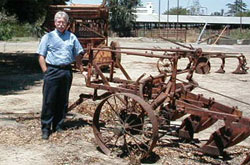Subsidy Failure Challenges Traditional Notions of Farming
"The family farm": The phrase exerts a powerful pull on the American imagination even in a nation that is largely urban and suburban.
"They are images that hearken back to when life was simpler," says Karl Stauber, head of the Northwest Area Foundation in St. Paul, Minnesota. "Part of it is, I think, the romantic notion that we have about other people having a simpler life where good and evil are much clearer. You're out there doing God's work—converting raw land into productivity."
Some of the nation's most disturbing and stirring images come from family farmers combating weather catastrophes and economic calamities, such as the Joad family and their neighbors in John Steinbeck's The Grapes of Wrath. Steinbeck captured the tragedy of farmers dispossessed by big farms and big banks during the Great Depression.
 |    |  |
 |
Checks from the federal government have accounted for about half of farm income over the past two years. |
 |
 |    |  |
"They come with the cats ... the cats, the caterpillar tractors," says Muley Graves, Joad's neighbor, driven mad after being driven from his land. "And for every one of 'em, there was ten, fifteen families thrown right out of their homes. A hundred folks and no place to live but on the road .... One right after the other, they got throw'd out. Half the folks you and me know throw'd right out into the road."
Farmers were hit hard by plunging prices during the Depression, and it's stories like this that moved the government to start subsidizing agriculture in 1933 under FDR.
The Agricultural Adjustment Act, a centerpiece of the New Deal, raised crop prices by paying farmers to cut back on production. Seven decades later, the government still heavily subsidizes the farm industry. Over the past 20 years, farmers have received more than $300 billion in taxpayer-financed support.
"The farm program provides a mechanism of support for family farmers and ranchers when the market doesn't provide adequate compensation for the production of food and fiber in this country," says Leland Swenson, the outgoing president of the National Farmer's Union. The Union is a 100-year-old organization that strongly advocates government support of the family farm.
"We are fortunate in this country", he says, "by the system we have in agriculture to have a diversified food system and we can provide to consumers the most abundant supply and safest supply of food of an y country in the world. We do that domestically. We don't have to rely on imports to feed our people. And I think we have to make sure by the structure of farm policy that we sustain that."
Farmers now make up less than two percent of the work force, down from 21 percent in the early 1930s. Stauber says the subsidies aren't working.
"I understand the political and romantic base for encouraging people to stay in farming, but I would argue we are better off helping those people to make the transition to other kinds of enterprises, to other kinds of opportunities," he explained. "Right now, I would say much of our federal policy and much of our state policy is sending the message: 'Stay in it; it will get better.' Well, it's gotten marginally worse every decade for the last four to five decades."
 |    |  |
 |
 |
 |
 |  |  |
 |
Agriculture economist Steven Blank thinks that Ukraine will eventually threaten America's wheat belt.Click photo to enlarge
Photo: Chris Farrell |
 |
 |    |  |
Farmers limped into the 1990s following the farm depression of the 1980s. Direct government payments accounted for nearly half of net farm income in 1999 and 2000, and an estimated 40% last year, according to Vernon Eidman, a professor of applied economics at the University of Minnesota.
Little wonder the cry "save the family farm" is once again being heard in rural towns, as well as in Washington, D.C.
"I don't think there is any substitute for the footsteps and footprints of family farmers when it comes to growing safe and affordable food," says Senator Paul Wellstone of Minnesota.
"The debate is not going to be over the farm bill, " says Maya McGuineas, a policy analyst at the New America Foundation in Washington, D.C. "It's going to be over the timing and distribution of the rather large chunk of money both parties are willing to plow into farm subsidies."
But agriculture economist Steven Blank at the University of California, Davis, wonders why farming should be treated any differently from computers, the dry cleaner on the corner, or most any other product and service in the economy? His grandparents on his mother's side were farmers and ranchers. His other grandparents ran a mom and pop grocery store as well as a butcher shop.
"Why were my mother's parents doing something more valuable than my father's parents?" Blank asked. "They were both part of the food chain. Why should the government pay one and not the other?"
Farming might have evolved into a far more profitable industry than it is without subsidies. And there's no question that the global competitive pressure will only intensify. Emerging Markets like China, Brazil, and Ukraine are devoting more resources toward upgrading their agricultural industries. Professor Blank thinks that Ukraine will eventually threaten America's wheat belt.
"Mother Nature happened to give the Ukraine some of the best land in the world—and the climate too—for growing crops such as wheat," Blank said. "And as soon as they get their infrastructure together—not only their production, but the ability to get it off the farm and to the market, as it gradually gets up to the standards that we operate on in this country—they will be able to underbid us and all the parts of the U.S. which are not quite as good will not be as competitive."

